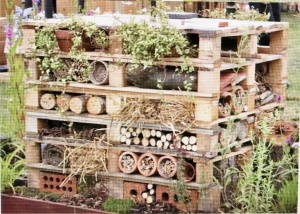
Is this just not totally cool?
It’s a stack of pallets all decked out with a purpose. Read on . . . .
Texas A&M AgriLife Extension Program Specialist, Dr. Wizzie Brown, presented a fascinating lecture recently entitled, Creating a Backyard Habitat for Insects.
Most folks who know me know that I’m a die-hard advocate for brush piles. My first Blog was on Brush Piles — February 15, 2015. If you’d like, you can view it here:
Creating an insect habitat goes beyond brush pile creating and can be fun, imaginative and innovative as well.
Beyond the Brush Pile
Dr. Brown began her lecture with a profound statement: “Without pollinators, we’d have no beautiful flowering plants.” I’m thinking, no flowers means no butterflies. Now that would be sad!
Dr. Brown went on with what I think is a pretty cool idea. Helping out the pollinators, especially in winter.
One of her first suggestions, which I liked extremely well, as I already do it, is to leave the garden a mess during the winter. I love it when laziness pays off.
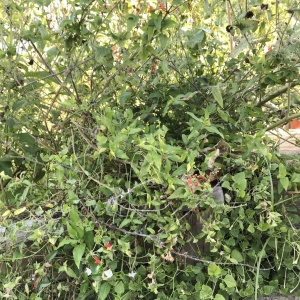
The photo above depicts a small corner of my butterfly garden that I leave to its own devices all year long. Who knew I was doing something constructive. I’m taking this as what Dr. Brown described as “leaving the garden a mess.”
The lower level has Berlandier’s trumpets, Acleisanthes obtuse, growing from the space between the retaining wall boards. Above, in the soil, is a jumble of scarlet sage, Salvia coccinea, widow’s tears, Commelina erecta, and Ruellia, Ruellia nudiflora, which keep re-populating themselves and providing nectar for hummingbirds, butterflies and night moths. Berlandier’s trumpets bloom in the evening and close by sun up.
The corner also contains fallen leaves from the potato tree, Solanum erianthum, above it, and compost and debris from my propagating and re-potting projects. It also houses bugs, fire ants and things unknown. Dr. Brown calls this easy concept, “an opportunity to let nature be nature.”
Snags
An interesting suggestion Dr. Brown had was to leave snags in a garden. I do come up against snags once in a while. Like the mysterious phenomenon in my garden where I can do my morning walk-through with a cup of coffee, and a tree has suddenly died. No warning, no howdy-do, by your leave, nothing — just gone!
Take for instance the four-year-old prolific-blooming Mexican Caesalpinia, Caesalpinia Mexicana. One morning last week, it’s pushing out new leaves and then the next day, dead! Sure it was planted too close to the potato tree, but it didn’t seem to mind those close quarters the last four years; its canopy figured out how to reach its own air, space and sun. Fortunately, it has left a few numerical reliefs that will be better positioned.

That sort of snag is not what Dr. Brown was referring. Now that the tree is dead though, leaving it in place in the garden, it has become a snag, not a dead tree. Leaving small, dead trees in a garden is beneficial to insects and beyond. I’ll leave it through the winter, see how it goes. There are other fun things to do for insects that are less noticeable — like mini brush piles all over the place:
· Leave your plants throughout the winter, even those that you might be thinking of clearing out to make the garden neat and tidy. Plants at various levels provide different layers of protection and habitat for different insects through the winter.
· Tuck a rotting log under a shrub or two, or place it amongst a dense mass of plants
· Artfully place a bundle of twigs and leaves or partially hide leaves in crevices
· Pile small rocks in various places
· Leave a rocky and bare (un-mulched) area of soil for insects to lay eggs
There are even things to make, which might be excellent projects for workshops with children and adults alike.
Insect Hotels and Bee Boxes
This little gem is an Insect Hotel.

It is a stack of six pallets. The cavities are filled with things that will deteriorate, which bugs will love. Bricks with holes in them provide fun little tunnels for bugs to crawl through. Possible fill material includes bundles of sticks, rolled corrugated cardboard, small pieces of cardboard, earth clods with grass, logs of varying sizes, straw, seed pods, even shredded newsprint or white paper, sawdust, wood chips, mulch . . . .
I particularly like the potted vines in the top spaces and the plants and rotting log around the base of the “sculpture.” The logs with holes drilled in the ends are similar to the Bee Box concept. Non deteriorating objects were used for creativity.
Pallets are prevalent, cheap and sometimes free.
Dr. Brown noted in her lecture that plants require air, water, food and light. Insects require air, water, food and shelter.
A truly simple insect hotel for children to build is to take a large, empty coffee can, stuff it with any combination of shredded bits of cardboard, shredded paper or newsprint, wood chips, seed pods, sticks and leaves. This hotel would be placed lying on its side on the ground in a garden with the opening facing east to southeast.
Here are examples of Insect Hotels shared during the lecture:


Water is a must for insect habitat. There are as many ideas as your imagination allows. Some require manually filling pretty often. Other forms purchased from pet or farm stores will need less attention.
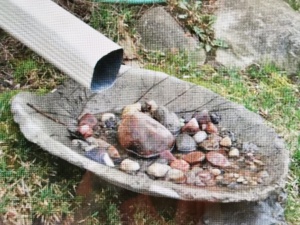

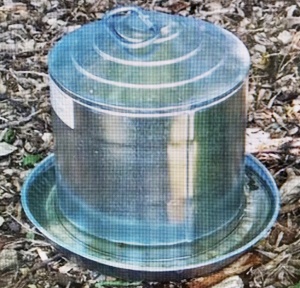
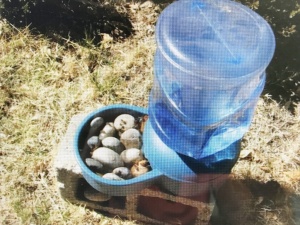
Bee Boxes
Bee boxes should have some sort of “roof” over them. It’s as simple as drilling holes in wood. A 5/16 inch drill bit is a good size; don’t drill holes completely through. A 8 to 12 inch long 4X4 would allow holes drilled to about 3 1/2 inches deep.
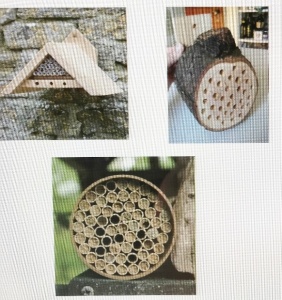
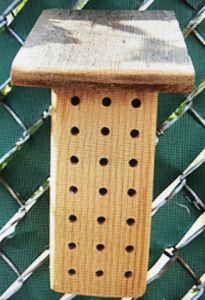
If you would like more information about Insect Hotels or building Bee Boxes, send your e-mail address to jjvanm@gmail.com
So cool to know. Now my husband cannot burn the wood/brush pile. There is a Long Bill Trasher living there.
Oh, WOW! And how cool is that! Great!